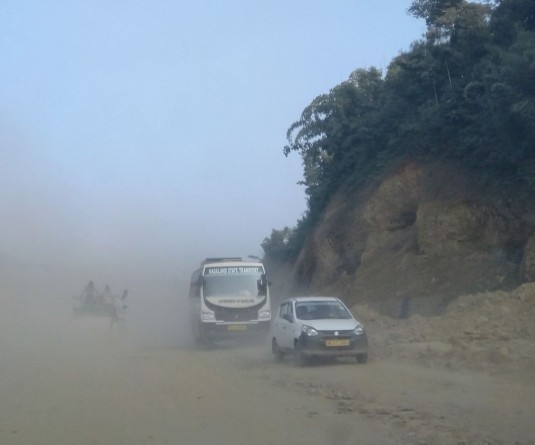Despite good performance on some parameters in the State of the Education Report (SOER) for India 2021, there were also several areas where Nagaland was lagging behind others with potential to negatively impact the provision of quality education.
Highlights both negative and positive ‘State of Education’
Morung Express News
Dimapur | October 13
The number of ‘unqualified teachers’ in Nagaland is among the highest while the State ranked low in the provision of basic amenities and ideal working conditions for teachers, a report by UNESCO has highlighted. The State, however, scored well on some parameters.
The State of the Education Report (SOER) for India 2021: “No Teacher, No Class” was launched by the United Nations Educational, Scientific and Cultural Organisation (UNESCO) on ‘World Teacher’s Day’ (October 5).
The report was developed based on analysis of secondary data and review of literature including policy documents and reports, case studies as well as analysing two data sets – Unified District Information System for Education (UDISE+) 2018/19 round and the Periodic Labour Force Survey 2018/19, the UNESCO informed.

What’s working for Nagaland?
As per the report, there were a total of 2,752 schools in Nagaland, out of which 82% were located in rural areas. A total of 32,015 teachers were employed in these schools, including 70% in rural areas.
Against 50% of total women teachers at the national level, the State percentage was 53%.
The State also scored well in terms of single-teacher schools, vacancies, and teacher requirement.
Schools with vacancies were just 2% of the total against the national average of 19% while teacher requirement was 413 (37% rural). Further, only 1% of the total schools in the State had ‘Single-teacher schools’ against All-India average of 7%.
The UNESCO designated Nagaland on those parameters ‘very good.’
The report also highlighted the State government’s initiative of distributing learning materials on pen drives at a nominal charge to interested parents during the COVID-19 pandemic.
What’s not working for Nagaland?
Despite good performance on parameters cited above, the report also highlighted several areas where the State was lagging behind others with potential to negatively impact the provision of quality education.
i) Under-qualified teachers
Chief among them were teacher’s qualification and working conditions including provision of basic amenities and professional working conditions in schools.
A significant share of teachers in the pre-primary, primary and upper primary levels neither possess academic degrees nor a professional degree (such as a Bachelor of Education) or a certificate in basic teachers training, the report observed.
The problem was most acute in Nagaland from pre-primary to upper primary level.
As per the report, percentage of ‘underqualified teachers’ in Nagaland in the pre-primary level was 20.77%, the third lowest in India after Meghalaya (33.17%) and Sikkim (37.53%) against the All-India average was 7.69%.
In the primary level too, Nagaland’s rank was 3rd from the bottom at 30%, after Meghalaya (33.91%) and Tripura (51.65). The national average was just 4.56%.
In the upper primary, at 15.5% against national average of 3.27%, Nagaland had highest percentage of ‘underqualified teachers.’
The percentage improved to 1.84% in the secondary level, though it was below the national average of 0.75% and was fourth lowest in India.
All the North East States performed poorly on these parameters.
However, in the higher secondary level, Nagaland was ranked 0.17, above the all-India average of 0.22.
According to the UNESCO, “Quality of teaching, teachers, and teachers’ education are central to delivering quality education for all” and enables “transformative potential for individuals, communities and for overall national development.”
ii) Poor working conditions
The report also highlighted a relatively poor working conditions of teachers in the State with regard to provision of basic amenities and professional working conditions.
Among others, availability of functional drinking water in Nagaland’s schools was among 3rd lowest in lowest in Nagaland at 59% against the national average of 91%. Only Arunachal Pradesh (52%) and Meghalaya (34%) were ranked below Nagaland.
At 57%, the State was ranked among the lowest in ‘All classrooms in good condition’ parameter. The national average here was 65% (62% rural and 83% urban).
The same was the case for availability of working electricity (63%) against All-India level of 74%. It performed relatively better in access by road and availability toilets at 82% and 88% respectively.
Only 27% of the schools in Nagaland have libraries, the fourth lowest in India (66%), the report informed, highlighting the professional working conditions in schools.
Internet availability as well as information and communications technology (ICT) lab was just 15% and 5% respectively in Nagaland, though the national averages were also 19% and 5% respectively.
Overall, 73 per cent of all schools (76 per cent of rural and 57 per cent of urban schools) report visits by academic supervisors in India. In Nagaland, it was 62% while percentage of schools receiving free textbooks in Nagaland was 72% against national average of 78%.
Again, the North East states as a whole performed poorly on parameters under professional working conditions in schools.
iii) Recruitment process
Based on the Performance Grading Index (PGI) pertaining to teacher recruitment, the report also informed that Nagaland was among the states scoring lowest (below 20%) in the transfer of teachers through a transparent online system and recruitment of head teachers/ principals through a merit-based selection system.
Again, the North East states as a whole performed poorly on these parameters.
Among others, the report called for improving working conditions in north-eastern states, rural areas and 'aspirational districts.’
Working conditions in these ‘difficult to staff’ regions also need to be improved, including basic amenities, better provisioning of libraries, and access to ICT, it added.
According to the UNESCO, with an in-depth analysis of the current state of teachers in India, the report is aimed at serving as a reference for enhancing the implementation of the New Education Policy (NEP) and towards the realization of the SDG.4 target 4C- substantial increase of qualified teachers.
It further attempted to provide an understanding of key aspects of the teaching profession and provided a profile of the 9.6 million teaching workforce, as well as the challenges they faced during their teaching routine and professional development.
Percentage of ‘underqualified teachers’ in NE
|
State |
Pre-Primary |
Primary |
Upper Primary |
Higher Secondary |
Higher Secondary |
|
Arunachal Pradesh |
17.07 |
11.51 |
4.06 |
0.28 |
0.07 |
|
Assam |
17.39 |
19.49 |
12.61 |
2.96 |
0.47 |
|
Manipur |
16.02 |
11.66 |
3.58 |
0.4 |
0.05 |
|
Meghalaya |
33.17 |
33.91 |
15.03 |
2 |
0.2 |
|
Mizoram |
17.1 |
7.05 |
3.6 |
0.67 |
0.05 |
|
Nagaland |
20.77 |
30 |
15.5 |
1.84 |
0.17 |
|
Sikkim |
37.53 |
22.55 |
3.43 |
0.79 |
0 |
|
Tripura |
19.8 |
51.65 |
1.66 |
0.19 |
0.14 |
|
All India |
7.69 |
4.56 |
3.27 |
0.75 |
0.22 |
Source: State of the Education Report (SOER) for India 2021: “No Teacher, No Class”
Professional working conditions in schools in NE
|
State |
Total Schools |
Availability of library |
Availability Of internet |
Availability of ICT lab |
Visits by academic supervisor (CRC or BRC*) |
Schools receiving free textbooks |
|
Arunachal Pradesh |
3,793 |
13% |
-NA |
NA |
NA |
NA |
|
Assam |
66,324 |
46% |
6% |
3% |
89% |
89% |
|
Manipur |
4,844 |
17% |
13% |
4% |
91% |
74% |
|
Meghalaya |
14,669 |
4% |
4% |
2% |
83% |
63% |
|
Mizoram |
3,913 |
10% |
7% |
3% |
89% |
59% |
|
Nagaland |
2,752 |
27% |
15% |
5% |
62% |
72% |
|
Sikkim |
1,290 |
45% |
19% |
11% |
90% |
88% |
|
Tripura |
4,945 |
15% |
3% |
1% |
86% |
95% |
|
All India |
15,51,000 |
66% |
19% |
5% |
73% |
78% |
#Block and cluster resource persons (BRCs and CRCs); NA: Data not Available.
State of the Education Report (SOER) for India 2021: “No Teacher, No Class”






